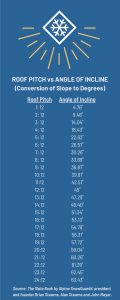Alpine SnowGuards innovated the market’s first and only solar snow management system. With almost a decade of research and development, we’ve developed a three-part system that has been rigorously performance tested at our in-house research facility. Alpine’s Guide for Solar Arrays & Snow Management on Shingle Roofs explains how snow and ice interact on solar panels attached to shingle roofs. Let our expertise advise you on best practices and solutions to your immediate needs.
Shingle Roof Pitch, Sliding Snow, and Snow Loads
Snow falls in an even blanket on the roof. As temperatures rise and sun exposure occurs, melting occurs. Water runs down through the snow pack to the roof surface and then down the roof surface under the snow. This creates lubrication between the snow pack and the roof surface.
- Most shingle roofs have granules that create friction while allowing melt water to run between the granules, which helps keep snow and ice from sliding off the roof surface
- Shingle roof pitches vary from 2/12 – 16/12
Adding a solar array to the roof essentially adds a glass roof surface over the shingle roof surface, changing the snow slide dynamic on your roof. Glass is a flat, hard and non-porous surface. Any melt water acts as a lubricant to reduce friction and the snow slides freely on much lower pitches than on an asphalt shingle roof; meaning avalanches occur more frequently and with greater velocity on a solar array compared to an asphalt shingle roof.
For more information about roof pitch, sliding snow, and snow loads, refer to American Society of Civil Engineers Guide to the Snow Load Provisions of ASCE 7-16.
How Solar Panels Affect Shingle Roofs
Granules add friction to the surface of shingled roofs. That surface becomes frictionless when glass solar panels are attached to the roof. This means solar arrays in snowy regions with a pitch of 2/12 or greater will likely shed snow and ice in a sudden avalanche-like event.
Avalanche Events on Solar Panels
Avalanching snow and ice off solar panels can cause property damage and injury to people and pets. Some examples of property damage include: plumbing vent pipes, gutters, lower roof areas, skylights, shrubs, cars, decks, and hot tubs, to name a few.
Areas in Need of Added Protection
At a minimum, points of egress, walkways, driveways, and gathering areas such as decks should be addressed with every new installation. Areas where gutters might get damaged, shrubs flattened, or roof vents broken should be considered by the project owner as worth taking a risk. These areas are often reconsidered after an array has been installed for a year or two and the owner has a better idea of locations that may justify added protection.
Solar Installer’s Responsibility
It’s the responsibility of the solar installer to plan new installations, while allowing for a roof landing zone and a roof-mounted snow management system to be supplemented by array-mounted devices. For existing arrays that do not have a landing zone, the installer should either remove panels to allow for the landing zone, or understand that the array-mounted snow guards alone are limited in height, and are therefore, also limited in function.
Alpine recommends homeowners reach out directly to their solar installer to start a quote via our Solar Snow Guard Calculator. Installation of our products by solar installers can protect the performance, safety and warranty of the solar array.
Alpine’s Recommended Solar Snow Management System
Alpine’s three-part solar snow management system works to slow the sudden release of snow and ice from solar panels attached to new and existing asphalt shingle roofs:
- Solar Snow Dog, Alpine’s pad-style solar panel-mounted component, attaches directly to the panels and should be installed to add friction points across the panels’ surface
- Solar SnowMax Universal, Alpine’s fence-style snow retention system, attaches directly to the bottom of the solar array, adding an additional barrier and preventing the release of a large snow mass that could cause property damage and injury to people and pets
- SSG-313, installing Alpine’s roof-mounted pipe-style system is strongly recommended as an additional barrier when a minimum 24” landing zone is available below the array
Each solar snow guard product page contains BIM Revit files, cut sheets, assembly sheets, installation instructions, specification sheets, and more:
- Solar Snow Dog, pad-style solar snow guard
- Solar SnowMax Universal, fence-style solar snow guard
- SSG-313, roof-mounted pipe-style solar snow guard
We keep snow in its place
888.766.4273
Sign up to start using our Snow Guard Calculator for FREE recommended layouts, BOM’s, pricing, system comparisons, and much more!
Subscribe to our monthly newsletter and keep up on the latest industry and Alpine news, products, and upcoming events!
Alpine SnowGuards designs, engineers, and manufactures snow management systems from our facilities in Morrisville, VT. We work closely with leading roofing contractors, engineering firms, developers, and roofing manufacturers to ensure we deliver quality products that do what we say they’ll do. Alpine SnowGuards can help a building qualify for LEED® credits.


